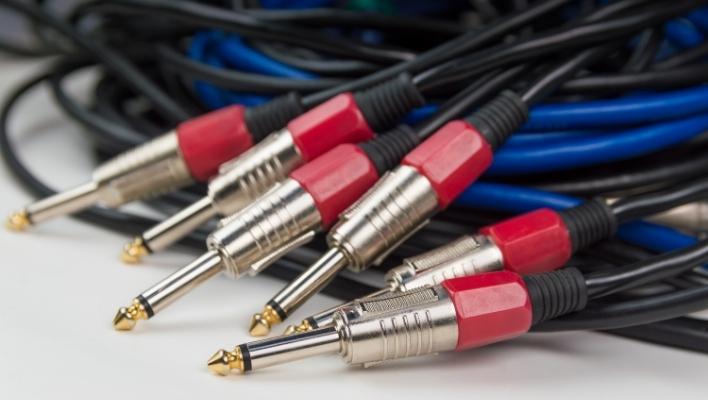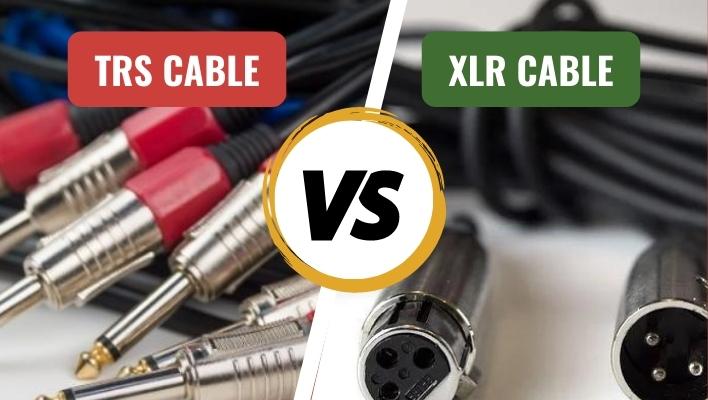Do you have a project involving sound design and recording as integral parts? If yes, one of the critical things you would have to regard would be the cable type to set up your studio.
The superiority of TRS vs XLR cable has been a heated discussion for quite some time. While you might think they are interchangeable, they have many fundamental differences in their performance. So, if you are looking for a new cable to hook your audio devices, it is essential to know the benefits and pitfalls of each type.
This article advises you on the best connector between XLR vs TRS cable. So let’s get this debate going!
What Is a TRS Cable?

A TRS cable is an audio cable used to attach audio devices to other devices such as sound cards or amplifiers. The name stands for “tip-ring-sleeve,” which refers to the distinct parts of the cable: the tip, the ring, and the innermost sleeve.
The tip goes into your microphone or headphones while the ring connects to the port on your soundboard. The sleeve (ground wire) shields you against any electrical shock while using the cable. TRS cables are color-coded, so you can tell where each end goes. The red end is for the left channel and black for the right channel.
A TRS cable may not be the best bet if you are a rock guitarist looking for the best cable to hook your guitar to the amplifier’s contact point. Such cases require you to invest in a mono cable that transmits unbalanced mono signals. We suggest this affordable and high-quality TS cable.
So what’s the difference between TS and TRS cables?
Unlike the TRS, the TS (tip-sleeve) unbalanced cable can relay stereo signals in long cables without interference. This allows you to give your fans a great show because you can move freely without worrying about noise distortion in your sound.
Types of TRS Connectors
There are three common TRS connector types: stereo, mono, and balanced. So what does each stand for?
Stereo TRS connectors have two tips (one on each side), two rings (one on each side), and two sleeves (one on each side). They’re used for connecting multiple speakers to an amplifier or recording device so that they can be played back through four speakers instead of just two at once.
Mono TRS connectors have a single tip, ring, and sleeve. They’re typically used for headphones to send left and right channels to the left earcup.
Suppose a stereo TRS connector has a ground and a signal pin. In that case, it will be a “balanced” connector since it recedes noise by adding a shielding layer around the wires inside the jack itself.

What is XLR?
An XLR (eXternal Line Return) is a line-level cable used to connect audio equipment. It’s a three-pronged cable with two signal wires and one ground wire. The purpose of the ground wire is to prevent interference from electromagnetic fields, which can cause noise in audio equipment.
XLR cables are typically used for professional applications, such as live sound and recording in studios. They’re also used to connect microphones and other equipment that requires balanced connections.
The main benefit of using an XLR balanced cable is its high sound quality compared to other types of plugs. With an XLR connection, the noise gets reduced, and sound quality is improved because each balanced signal travels through two wires instead of just one.
TRS to TRS vs TRS to XLR Connections: Which Is Best for Your Needs?
If you’re looking for a way to connect your devices, knowing which connection type is right for your needs can be confusing. Luckily, we’ve put together a guide to help you decide between TRS and TRS to XLR connections.
First, you should think about whether or not you need a balanced signal. Connecting using TRS jacks will be fine if you don’t need a balanced signal. However, if you want to ensure that both channels of your audio signal are balanced, then an XLR connection is likely your best bet.
Fortunately, you can convert the unbalanced signals using a DI box (direct box). Just connect it between the source and the input of your amplifier and let it take care of the conversion for you.
Second, you should consider how much space you have available for your cable. If you need longer cables than a TRS connection provides, then an XLR connection may be more suitable for you.
In addition, if you want to connect two speakers, then a TRS will be appropriate. However, if you’re going to hook one speaker and a microphone, an XLR connection would be more appropriate because it handles the extra phantom power from the microphone without damaging your audio device.
Lastly, consider the level of versatility. TRS to XLR offers more versatility than TRS connections as you can use them with professional equipment such as microphones or speakers and consumer electronics such as headphones and speakers. So if you have both types of equipment, this connection type will work well for all of them!
TRS vs XLR For Studio Monitor— Best Pick?
There are many ways to connect your speakers to your computer in a studio, but which is the best?
TRS connectors are easy to use and don’t need any extra equipment or cables to connect them. On the contrary, XLR requires an adapter to convert them into a TRS connector and then an additional cable between the adapter and your speaker system.
We recommend using XLR connectors if you have enough space for all of their components (adapter and cable). They provide better audio quality with less interference from outside sources like electromagnetic fields.

Is XLR Better Than TRS—Pros and Cons Explained
The obvious pro to consider when using an XLR vs TRS is sound quality. With an XLR connector, there’s no chance of interference between the left and right channels, so all you’re left with is pure audio quality!
Unlike the TRS, the XLR has a locking mechanism to secure and prevent it from accidental disconnection. This ensures that your audio equipment stays safe and well protected for a long time.
On the other hand, TRS connections are easier to use than XLR because they don’t require any special tools to connect or disconnect them. Just plug them into your device!
The jack for TRS connectors is much cheaper than XLR jacks. Thus, making them ideal for budget-conscious consumers who need high-quality audio equipment but don’t want to spend a fortune on it.
Conclusion
Ultimately, the best cable for your sound design project depends on your specific needs. As a designer, you’ll need to consider how much signal gets transferred and interfered with by other sources. Both TRS and XLR connectors have pros and cons, but it all comes down to your specific needs. We hope that you’ve understood the differences between XLR vs TRS connectors.
